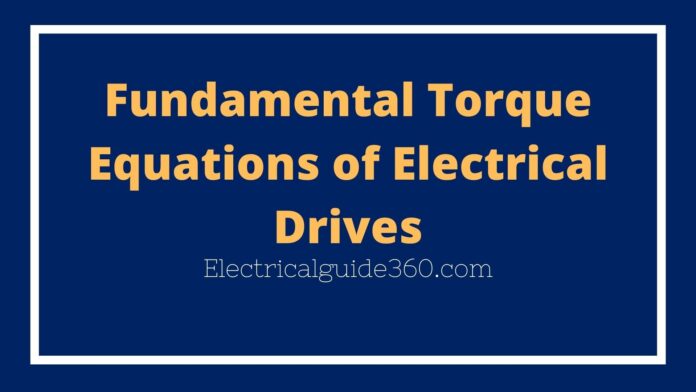Let’s learn about the fundamental torque equations of electrical drives.
So, when the motor gets started, the load connected to it may be rotational or may undergo translational motion. Therefore, the load speed is different from that of the speed of the motor. The equations below show the equivalent rotational system, Let’s represent the torque equation of the motor load system from it.
 Here,
Here,
J = Polar moment of inertia of motor-load system referred to the motor shaft, kg-m2.
ωm = Instantaneous angular velocity of the motor shaft, rad/sec.
T = Instantaneous value of developed motor torque, N-m.
T1 = Instantaneous value of load (resisting) torque, referred to the motor shaft, N-m.
From, fundamental Torque Equations of Electrical Drives, the above Figure (2.1) can be written as:![]()
Note that Equation (2.1) is applicable to variable inertia drives such as mine winders, reel drives, industrial robots.
For drives with constant inertia, (dJ/dt) = 0. Therefore,

In equation (2.2), Load torque T1 and dynamic torque J(dωm/dt) will balance the motor torque.
Drive accelerates or decelerates depending on whether T is greater or less than T1. During acceleration, the motor should supply not only the load torque but an additional torque component J(dωm/dt) in order to overcome the drive inertia.
Also Read: What is an Electrical Drives? Parts, Functions, Types, and Applications
In drives with large inertia, such as electric trains, motor torque must exceed the load torque by a large amount in order to get adequate acceleration. In drives requiring a fast transient response, motor torque should be maintained at the highest value and the Torque Equation of the Motor Load System should be designed with the lowest possible inertia.
Energy associated with dynamic torque J(dωm/dt) is stored in the form of kinetic energy given by (Jω2m/2). During deceleration, dynamic torque J(dωm/dt) has a negative sign. Therefore, it assists the motor developed torque T and maintains drive motion by extracting energy from stored kinetic energy.











Good educational material.